warning KIA Rondo 2007 2.G User Guide
[x] Cancel search | Manufacturer: KIA, Model Year: 2007, Model line: Rondo, Model: KIA Rondo 2007 2.GPages: 343, PDF Size: 3.61 MB
Page 26 of 343

313
Safety features of your vehicle
After getting in or out, simply slide the
2nd row seat backward and pull up the
seatback backward firmly until it clicks
into place. Make sure that the seat is
locked in place.
C010307AUNFolding the rear seatThe rear seatbacks (or cushions) may be
folded to facilitate carrying long items or
to increase the luggage capacity of the
vehicle.To fold the rear seat cushion and back:
- 7-seater (2nd row seat)
1. Insert the rear seat belt buckle in the
pocket between the rear seatback and
cushion, and insert the rear seat belt
webbing in the guide to prevent the
seat belt from being damaged.
2. Set the front seatback to the upright position and if necessary, slide the
front seat forward or the rear seat
backward.
WARNING
Never attempt to adjust while the
vehicle is moving or the 2nd row
seat is occupied as the seat may
suddenly move and cause the pas-
senger on the seat to be injured.
WARNING
The purpose of the fold-down rear
seatbacks (or cushions) is to allow
you to carry longer objects than
could not otherwise be accommo-
dated.
Never allow passengers to sit on
top of the folded down seatback
while the car is moving as this is
not a proper seating position and
no seat belts are available for use.
This could result in serious injury
or death in case of an accident or
sudden stop. Objects carried on the
folded down seatback should not
extend higher than the top of the
front seats. This could allow cargo
to slide forward and cause injury or
damage during sudden stops.
Page 29 of 343

Safety features of your vehicle16
35. To use the rear seat, lift and pull the
seatback backward by pulling on the
folding lever (or strap) (1). Pull the
seatback firmly until it clicks into place.
Make sure the seatback is locked in
place.
6. Return the rear seat belt to the proper position.
OUN026050LOUN026050E
■7-seater (3rd row seat)■5-seater
WARNING
When you return the rear seatback
to its upright position after being
folded down:
Be careful not to damage the seat
belt webbing or buckle. Do not
allow the seat belt webbing or
buckle to get caught or pinched in
the rear seat. Ensure that the seat-
back is completely locked into its
upright position by pushing on the
top of the seatback. Otherwise, in
an accident or sudden stop, the
seat could fold down and allow
cargo to enter the passenger com-
partment, which could result in
serious injury or death.
WARNING
- 3rd row seat
(if equipped)
The headrest on the 3rd row seat
should be adjusted so the middle of
the headrest is at the same height
as the top of the occupant's eyes.
If the tailgate is pushed down when
the passenger's head is not against
a properly adjusted headrest, the
tailgate may hit the occupant's
head, which could cause injury.
OUN026140
Page 30 of 343
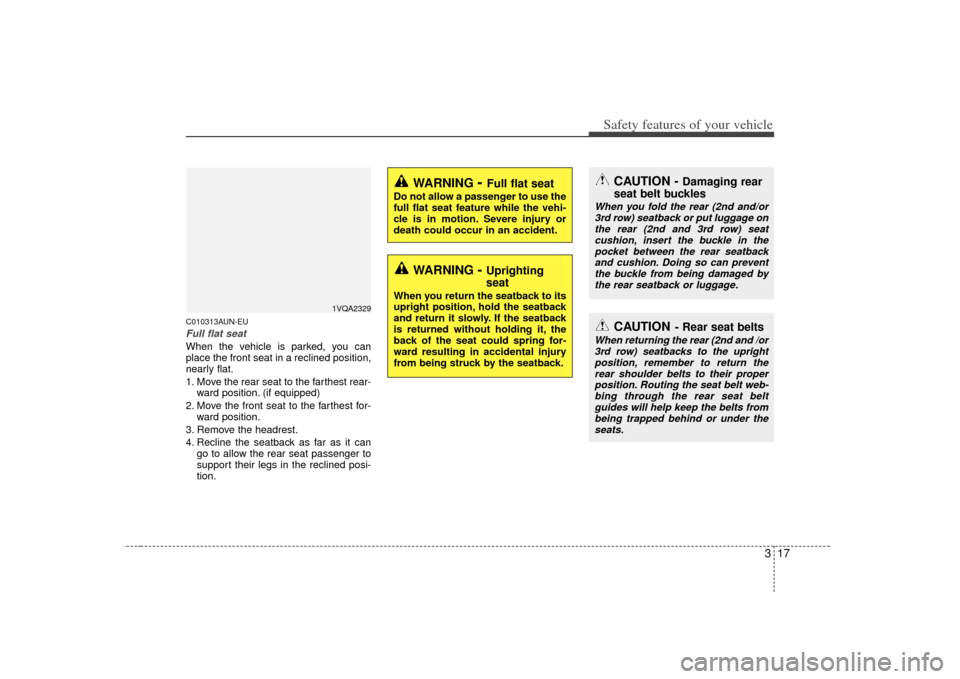
317
Safety features of your vehicle
C010313AUN-EUFull flat seatWhen the vehicle is parked, you can
place the front seat in a reclined position,
nearly flat.
1. Move the rear seat to the farthest rear-ward position. (if equipped)
2. Move the front seat to the farthest for- ward position.
3. Remove the headrest.
4. Recline the seatback as far as it can go to allow the rear seat passenger to
support their legs in the reclined posi-
tion.
1VQA2329
WARNING
- Full flat seat
Do not allow a passenger to use the
full flat seat feature while the vehi-
cle is in motion. Severe injury or
death could occur in an accident.
WARNING
- Uprighting
seat
When you return the seatback to its
upright position, hold the seatback
and return it slowly. If the seatback
is returned without holding it, the
back of the seat could spring for-
ward resulting in accidental injury
from being struck by the seatback.
CAUTION
- Rear seat belts
When returning the rear (2nd and /or3rd row) seatbacks to the uprightposition, remember to return therear shoulder belts to their proper position. Routing the seat belt web-bing through the rear seat belt guides will help keep the belts frombeing trapped behind or under the seats.
CAUTION -
Damaging rear
seat belt buckles
When you fold the rear (2nd and/or
3rd row) seatback or put luggage onthe rear (2nd and 3rd row) seatcushion, insert the buckle in the pocket between the rear seatbackand cushion. Doing so can prevent the buckle from being damaged bythe rear seatback or luggage.
Page 31 of 343
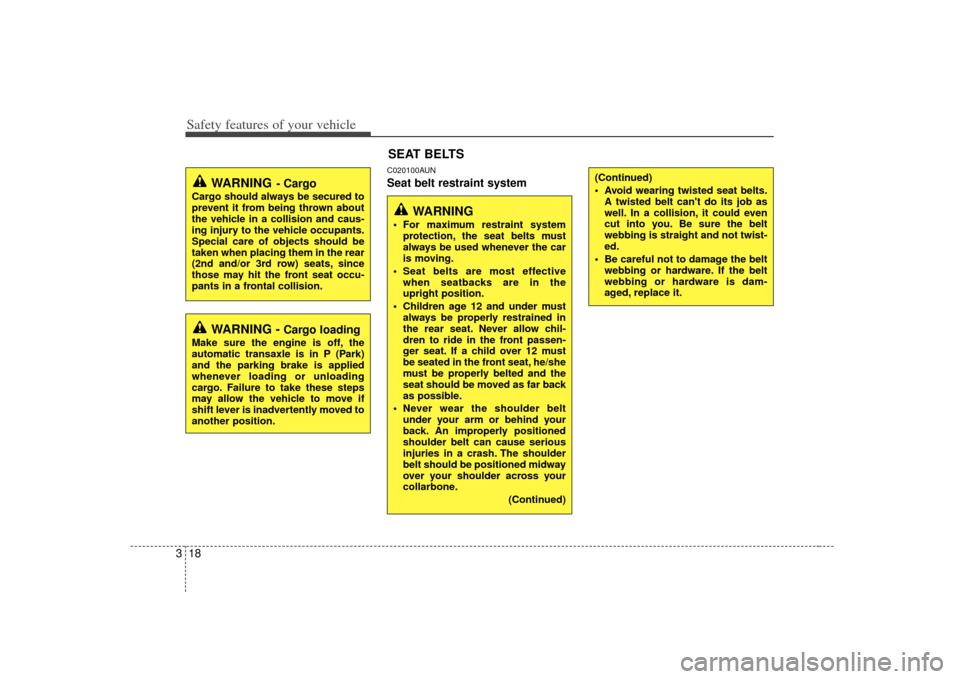
Safety features of your vehicle18
3
C020100AUNSeat belt restraint system
WARNING
For maximum restraint system
protection, the seat belts must
always be used whenever the car
is moving.
Seat belts are most effective when seatbacks are in the
upright position.
Children age 12 and under must always be properly restrained in
the rear seat. Never allow chil-
dren to ride in the front passen-
ger seat. If a child over 12 must
be seated in the front seat, he/she
must be properly belted and the
seat should be moved as far back
as possible.
Never wear the shoulder belt under your arm or behind your
back. An improperly positioned
shoulder belt can cause serious
injuries in a crash. The shoulder
belt should be positioned midway
over your shoulder across your
collarbone.
(Continued)
(Continued)
Avoid wearing twisted seat belts.A twisted belt can't do its job as
well. In a collision, it could even
cut into you. Be sure the belt
webbing is straight and not twist-
ed.
Be careful not to damage the belt webbing or hardware. If the belt
webbing or hardware is dam-
aged, replace it.
WARNING -
Cargo loading
Make sure the engine is off, the
automatic transaxle is in P (Park)
and the parking brake is applied
whenever loading or unloading
cargo. Failure to take these steps
may allow the vehicle to move if
shift lever is inadvertently moved to
another position.
WARNING
- Cargo
Cargo should always be secured to
prevent it from being thrown about
the vehicle in a collision and caus-
ing injury to the vehicle occupants.
Special care of objects should be
taken when placing them in the rear
(2nd and/or 3rd row) seats, since
those may hit the front seat occu-
pants in a frontal collision.
SEAT BELTS
Page 32 of 343

319
Safety features of your vehicle
C020101AUN-EUSeat belt warningDriver's seat belt warning
As a reminder to the driver, the driver’s
seat belt warning light will blink for
approximately 6 seconds each time you
turn the ignition switch ON regardless of
belt fastening.If the driver's seat belt is not fastened
when the ignition switch is turned ON or
if it is disconnected after the ignition
switch is turn ON, the driver's seat belt
warning light will blink for approximately
6 seconds and the seat belt warning
chime will sound for approximately 6 sec-
onds until the belt is fastened. If the dri-
ver's seat belt is not fastened for approx-
imately 36 seconds after starting the
engine, the driver's seat belt warning
light and chime will operate at most 11
times with a pattern of 6 seconds on and
24 seconds off or until the belt is fas-
tened.
Front passenger's seat belt warning
As a reminder to the front passenger, the
front passenger's seat belt warning light
will blink for approximately 6 seconds
each time you turn the ignition switch ON
regardless of belt fastening. If the pas-
senger's seat belt is unfastened when
the vehicle speed exceeds 10 km/h (6
mph), the passenger's seat belt warning
light will blink for at least 6 seconds or
until the belt is fastened.
OUN036023N
OUN036024N
Page 33 of 343
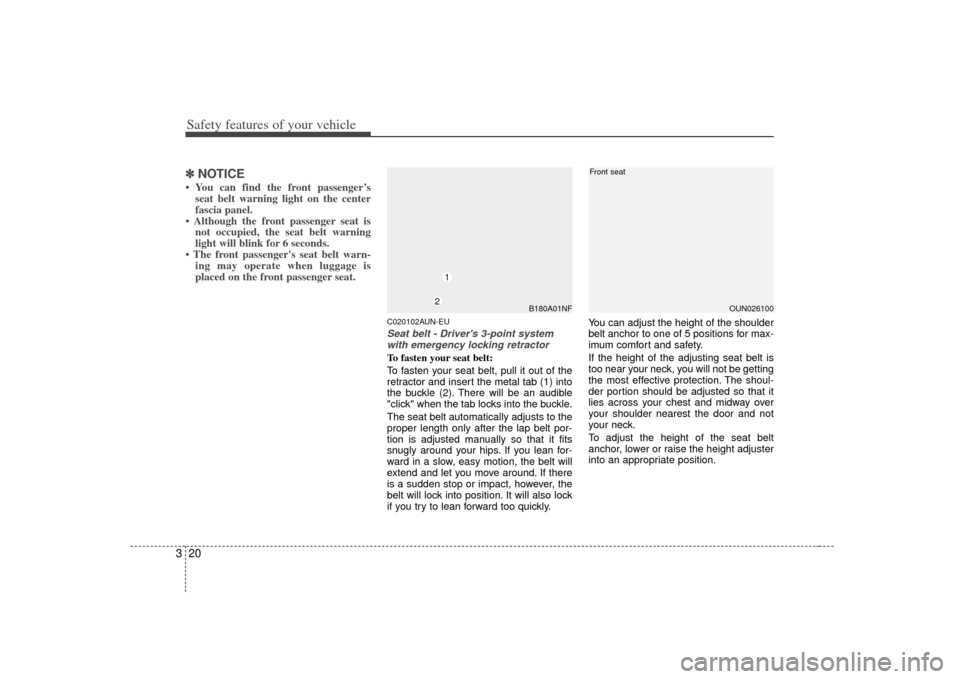
Safety features of your vehicle20
3✽
✽
NOTICE• You can find the front passenger’s
seat belt warning light on the center
fascia panel.
• Although the front passenger seat is not occupied, the seat belt warning
light will blink for 6 seconds.
• The front passenger's seat belt warn- ing may operate when luggage is
placed on the front passenger seat.
C020102AUN-EUSeat belt - Driver's 3-point system
with emergency locking retractorTo fasten your seat belt:
To fasten your seat belt, pull it out of the
retractor and insert the metal tab (1) into
the buckle (2). There will be an audible
"click" when the tab locks into the buckle.
The seat belt automatically adjusts to the
proper length only after the lap belt por-
tion is adjusted manually so that it fits
snugly around your hips. If you lean for-
ward in a slow, easy motion, the belt will
extend and let you move around. If there
is a sudden stop or impact, however, the
belt will lock into position. It will also lock
if you try to lean forward too quickly. You can adjust the height of the shoulder
belt anchor to one of 5 positions for max-
imum comfort and safety.
If the height of the adjusting seat belt is
too near your neck, you will not be getting
the most effective protection. The shoul-
der portion should be adjusted so that it
lies across your chest and midway over
your shoulder nearest the door and not
your neck.
To adjust the height of the seat belt
anchor, lower or raise the height adjuster
into an appropriate position.
B180A01NF
12
OUN026100
Front seat
Page 34 of 343

321
Safety features of your vehicle
To raise the height adjuster, pull it up (1).
To lower it, push it down (3) while press-
ing the height adjuster button (2).
Release the button to lock the anchor
into position. Try sliding the height
adjuster to make sure that it has locked
into position.
C020106AUNSeat belts - Front passenger and rearseat 3-point system with combinationlocking retractorTo fasten your seat belt:
Combination retractor type seat belts are
installed in the rear seat positions to help
accommodate the installation of child
restraint systems. Although a combina-
tion retractor is also installed in the front
passenger seat position, it is strongly
recommended that children always be
seated in the rear seat. NEVER place
any infant restraint system in the front
seat of the vehicle.
This type of seat belt combines the fea-
tures of both an emergency locking
retractor seat belt and an automatic lock-
ing retractor seat belt. To fasten your seat
belt, pull it out of the retractor and insert
the metal tab into the buckle. There will
be an audible "click" when the tab locks
into the buckle. When not securing a
child restraint, the seat belt operates in
the same way as the driver's seat belt
(Emergency Locking Retractor Type). It
automatically adjusts to the proper length
only after the lap belt portion of the seat
belt is adjusted manually so that it fits
snugly around your hips.
WARNING
Verify the shoulder belt anchor is locked into position at the appro-
priate height. Never position the
shoulder belt across your neck or
face. Improperly positioned seat
belts can cause serious injuries
in an accident.
Failure to replace seat belts after an accident could leave you with
damaged seat belts that will not
provide protection in the event of
another collision leading to per-
sonal injury or death. Replace
your seat belts after being in an
accident as soon as possible.
WARNING
You should place the lap belt por-
tion as low as possible and snugly
across your hips, not on your waist.
If the lap belt is located too high on
your waist, it may increase the
chance of injury in the event of a
collision. Both arms should not be
under or over the belt. Rather, one
should be over and the other under,
as shown in the illustration.
Never wear the seat belt under the
arm nearest the door.
B200A02NF
Page 37 of 343
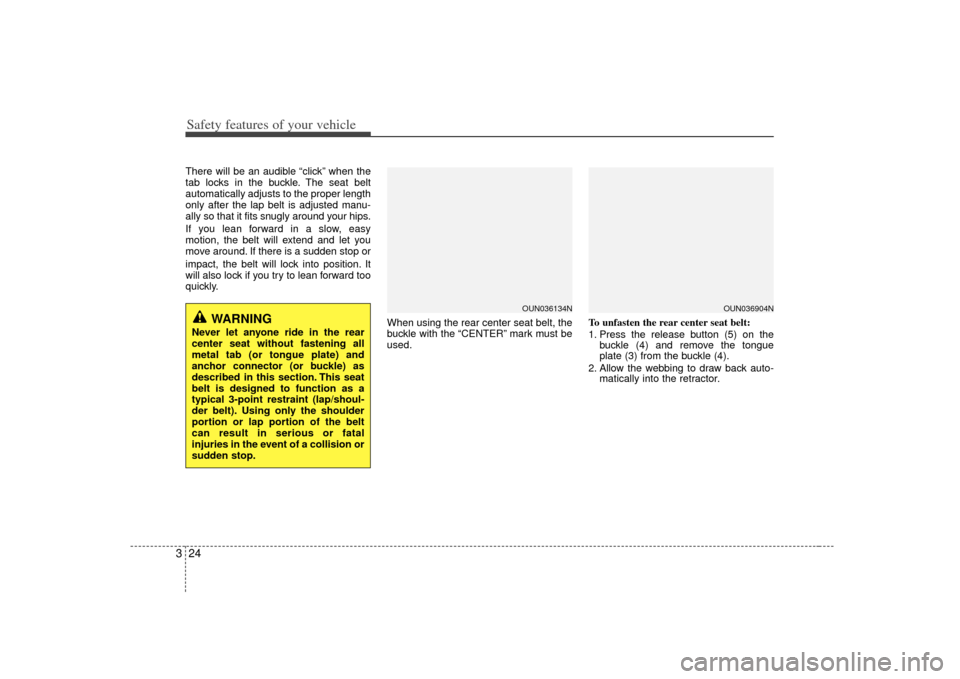
Safety features of your vehicle24
3There will be an audible “click” when the
tab locks in the buckle. The seat belt
automatically adjusts to the proper length
only after the lap belt is adjusted manu-
ally so that it fits snugly around your hips.
If you lean forward in a slow, easy
motion, the belt will extend and let you
move around. If there is a sudden stop or
impact, the belt will lock into position. It
will also lock if you try to lean forward too
quickly.
When using the rear center seat belt, the
buckle with the “CENTER” mark must be
used.To unfasten the rear center seat belt:
1. Press the release button (5) on the
buckle (4) and remove the tongue
plate (3) from the buckle (4).
2. Allow the webbing to draw back auto- matically into the retractor.
WARNING
Never let anyone ride in the rear
center seat without fastening all
metal tab (or tongue plate) and
anchor connector (or buckle) as
described in this section. This seat
belt is designed to function as a
typical 3-point restraint (lap/shoul-
der belt). Using only the shoulder
portion or lap portion of the belt
can result in serious or fatal
injuries in the event of a collision or
sudden stop.
OUN036134N
OUN036904N
Page 39 of 343
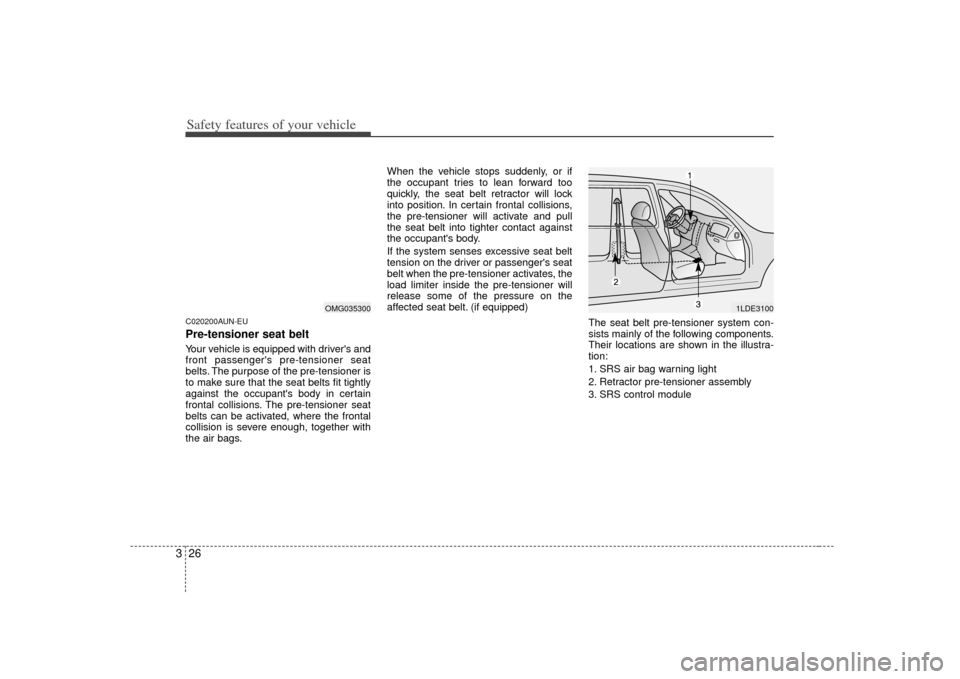
Safety features of your vehicle26
3C020200AUN-EUPre-tensioner seat belt Your vehicle is equipped with driver's and
front passenger's pre-tensioner seat
belts. The purpose of the pre-tensioner is
to make sure that the seat belts fit tightly
against the occupant's body in certain
frontal collisions. The pre-tensioner seat
belts can be activated, where the frontal
collision is severe enough, together with
the air bags. When the vehicle stops suddenly, or if
the occupant tries to lean forward too
quickly, the seat belt retractor will lock
into position. In certain frontal collisions,
the pre-tensioner will activate and pull
the seat belt into tighter contact against
the occupant's body.
If the system senses excessive seat belt
tension on the driver or passenger's seat
belt when the pre-tensioner activates, the
load limiter inside the pre-tensioner will
release some of the pressure on the
affected seat belt. (if equipped)
The seat belt pre-tensioner system con-
sists mainly of the following components.
Their locations are shown in the illustra-
tion:
1. SRS air bag warning light
2. Retractor pre-tensioner assembly
3. SRS control module
OMG035300
1LDE3100
Page 40 of 343
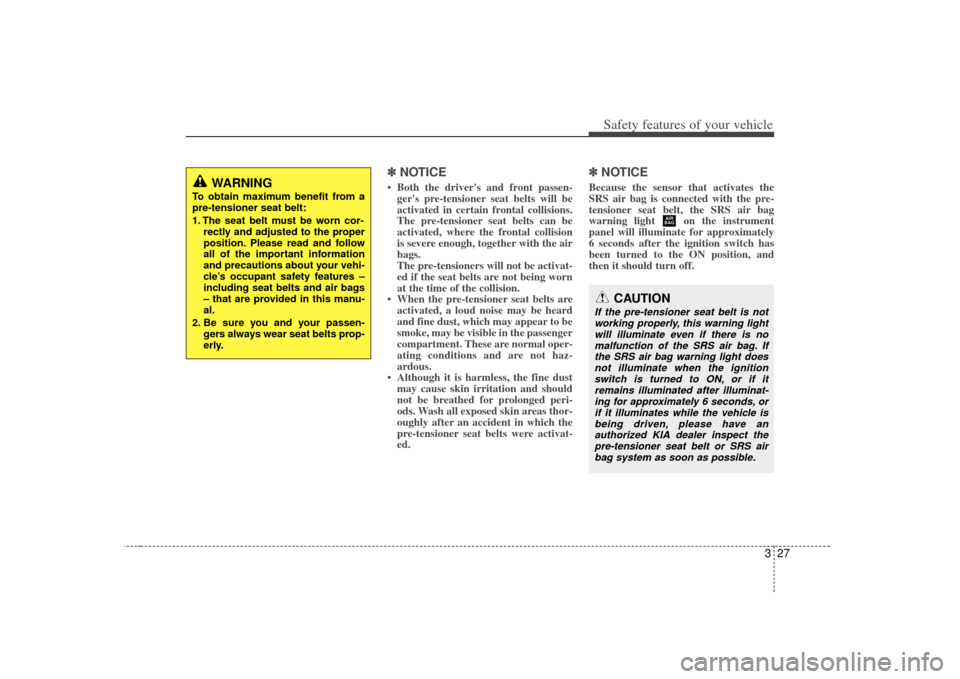
327
Safety features of your vehicle
✽
✽NOTICE• Both the driver's and front passen-
ger's pre-tensioner seat belts will be
activated in certain frontal collisions.
The pre-tensioner seat belts can be
activated, where the frontal collision
is severe enough, together with the air
bags.
The pre-tensioners will not be activat-
ed if the seat belts are not being worn
at the time of the collision.
• When the pre-tensioner seat belts are activated, a loud noise may be heard
and fine dust, which may appear to be
smoke, may be visible in the passenger
compartment. These are normal oper-
ating conditions and are not haz-
ardous.
• Although it is harmless, the fine dust may cause skin irritation and should
not be breathed for prolonged peri-
ods. Wash all exposed skin areas thor-
oughly after an accident in which the
pre-tensioner seat belts were activat-
ed.
✽ ✽ NOTICEBecause the sensor that activates the
SRS air bag is connected with the pre-
tensioner seat belt, the SRS air bag
warning light on the instrument
panel will illuminate for approximately
6 seconds after the ignition switch has
been turned to the ON position, and
then it should turn off.
AIR
BAG
WARNING
To obtain maximum benefit from a
pre-tensioner seat belt:
1. The seat belt must be worn cor-
rectly and adjusted to the proper
position. Please read and follow
all of the important information
and precautions about your vehi-
cle’s occupant safety features –
including seat belts and air bags
– that are provided in this manu-
al.
2. Be sure you and your passen- gers always wear seat belts prop-
erly.
CAUTION
If the pre-tensioner seat belt is notworking properly, this warning lightwill illuminate even if there is no malfunction of the SRS air bag. Ifthe SRS air bag warning light does not illuminate when the ignitionswitch is turned to ON, or if it remains illuminated after illuminat-ing for approximately 6 seconds, orif it illuminates while the vehicle is being driven, please have anauthorized KIA dealer inspect thepre-tensioner seat belt or SRS air bag system as soon as possible.